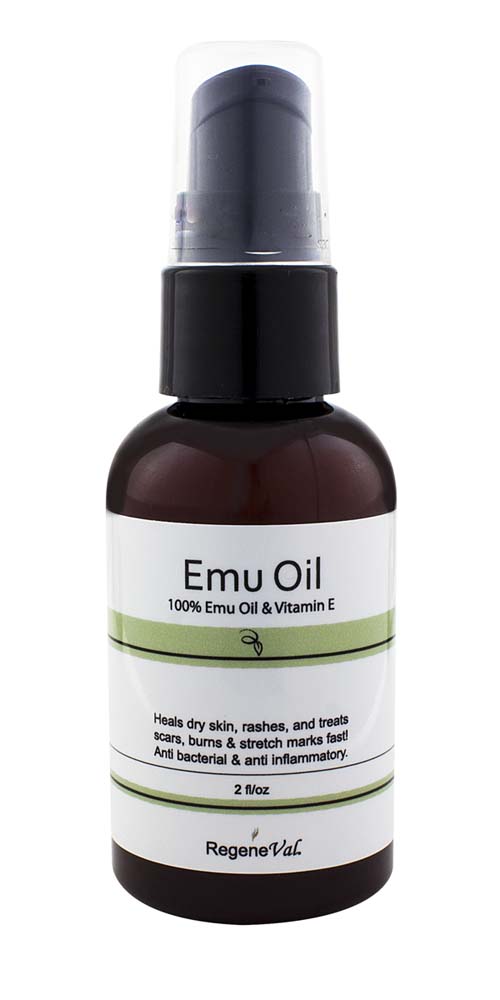Emu Oil Research
Emu oil is wonderful for the skin because it mimics the skins layers so well that the skin lets it pass through. This is important since most skin care products never pass the superficial and outer most layers of skin.
Emu oil is also known to awaken hair follicles as studied by Dr. Michael Hollick. The hair follicles became 20% more active since the emu oil works on the root of the hair. Emu oil products infuse moisture, penetrate deep into dermal layers and is an antibacterial anti fungal and anti-inflammatory.
Research studied have been conducted at these institutes:
|
Auburn University, USA
Iowa State University, USA
Texas Tech Health Sciences, Burn unit USA
Royal North Shore Hospital of Sydney, Australia
Medical School, University of Texas, USA |
Boston university medical center, USA
Indiana University School of Medicine, USA
Dept. of Medicine, University of Queensland, Australia
University of Adelaide, Australia |
...the following are some of the study results
*Fatty Acid Analysis of Emu Oil.
(AEA funded study,1994) By: Dr. Paul Smith, Dr. Margaret Craig-Schmidt, Amanda Brown at Auburn University. (reprinted from AEA news, September 1994 Issue)
Summary: Analysis of fatty acids in emu oil reveals that it contains approximately 70% unsaturated fatty acids. The major fatty acid found in emu oil is oleic acid, which is monounsaturated and which comprises over 40% of the total fatty acid content. Emu Oil also contains both of the two essential fatty acids (EFA,s) which are important to human health: 20% linoleic, and 1-2% alpha- linolenic acid - both have significant benefits.
*Emu Oil: A Source of Non-Toxic Transdermal Anti-Inflammatory Agents in Aboriginal Medicine
(1997)By: Dr. Michael Whitehouse and Athol Turner, Dept. of Medicine, University of Queensland, Australia. (Source: Inflammopharacology, San Francisco, March 1997 conference proceedings. Reprinted from AEA News, Summer 1997 issue).
Summary: Ongoing studies on the anti-inflammatory activity of emu oils, as tested using the arthritis-induced rat model, indicate that different emu oils vary in their ability to suppress arthritic symptoms and that a chemical test for biological activity is needed rather continuing to use the rat model.
*Experimental Study to Determine the Anti-Arthritic Activity of a New Emu Oil Formulation(EMMP)
(1993)By: Dr. Peter Ghosh at Royal North Shore Hospital of Sydney, Australia and Dr. Michael Whitehouse at University of Adelaide, Australia.
Summary: A combination of emu oil with a suitable transdermal transporter is found to show anti-inflammatory (anti-rheumatic) activity in various rat models.
*Emu Oil: Burn Study Results
(AEA Funded, 1995-1998) Report By: Margaret Pounder, AEA President. (Reprinted from AEA EMUpdate, Summer 1998 issue).
Summary: A long term study was initiated by DR. John Griswald, Director of the Timothy J. Harnar Burn Center( affiliated with Texas Tech University Medical Center, Lubbock Texas) in 1995 to analyze the potential effects of emu oil in the healing of re-epithelialized burn wounds. The study found that patients'' almost unanimously favored emu oil as an end result and during application", and that there was a statistically significant difference in scar reduction and inflammation of the emu oil treated wounds.
*Emu Oil: Comedogenicity Testing (Study done for E.R.I., 1993) By: Department Of Dermatology, At University Of Texas Medical school, Houston.
Summary: Testing using the rabbit ear histological assay, with emu oil in concentrations of 25%, 75% and 100% is non-comedogenic, i.e. it does not clog the pores of the skin.
*Fatty Acid Composition: Comparative analysis of emu, ostrich and rhea oil.
(1996) By: Dr. Margaret Craig-Schmidt and K.R.Willian at Auburn University.(Abstracts:88th AOCS annual Meeting & Expo, Seattle WA, May 1997)
Summary: A comparison between oil rendered from the fat of emu, the ostrich and the rhea reveals that the predominant fatty acid in ostrich and rhea oils is palmitic acid, and of emu is oleic acid.
*Moisturizing and Cosmetic Properties of Emu Oil: A double blind study
(1994). By: Dr. Alexander Zemtsov, Indiana University School of Medicine: Dr. Monica Gaddis, Ball Memorial Hospital; and Dr. Victor Montalvo-Lugo, Ball Memorial Hospital. (Reprinted from AEA news, October/November1994 issue)
Summary: Eleven human subjects took part in a double-blind clinical study which compared emu oil with mineral oil in texture, skin permeability and moisturizing properties, as well as comedogenicity and irritability to the skin. No irritation to the skin was observed with either oil. However , comedogenicity of emu oil was significantly lower than that of mineral oil, and all subjects stated a unanimous preference for emu oil.
*Composition of Emu Oil: The Micro View
(1997) By: Dr. Leigh Hopkins, AEA oil Standards Team( Research leader) Reprinted from AEA News, Spring 1997 issue.
Summary: when compared with human skin oil, the fatty acid composition of emu oil is found to be quite similar. In both types of oil, mono-unsaturated oleic acid is the most prevalent fatty acid, followed by the palmitic acid, which is an EFA ( essential fatty acid). This similarity may be one of the factors enabling emu oil to have such a positive action on human skin.
Click here for more articles and information on emu oil |